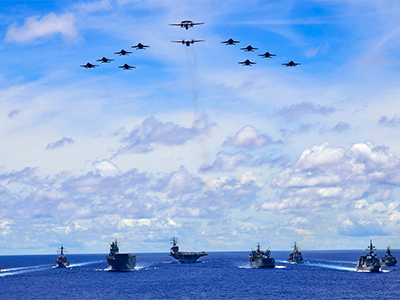The future of Defence command and control is agile

Dr Paul Gaertner is leading Defence’s Agile Command and Control STaR Shot.
Dr Gaertner describes Defence command and control (or C2) as the ‘connective tissue’ between all our Defence capabilities, operating across all the warfighting domains and at all operational levels – it’s what holds Defence together, enabling it to achieve its goals effectively and efficiently.
Success in future complex and contested environments will need capabilities from across all domains to achieve complementary and coordinated effects. Agile command and control will allow Australia to better use its military assets by allowing greater delegation of command authority and faster, more informed decision-making.
Improving our C2 system is pivotal to Defence success, and that is driving Dr Gaertner and his STaR Shot team to investigate what Defence’s future C2 capability needs to look like.
Modern command and control – a different beast
Haven’t we got command and control worked out? Dr Gaertner argues that existing C2 systems work well with traditional war fighting, but need to evolve. “The old ways of doing C2 don’t hold up in today’s environment. Technology and emerging threats keep changing, and Defence’s command and control has to adapt to keep up. We’re also seeing the potential of emerging technologies such as artificial intelligence and new social and cultural aspects all coming into play.”
So what does agile C2 look like? “We could talk on this topic for hours, because it means different things to different people. I think about agility in C2 as flattening structures of control, and possibly also authority, so that when comms are disrupted the forces can continue their missions. It’s also about decentralisation of C2, and being able to adapt your C2 structure depending on your situation.”
According to Dr Gaertner, the future of C2 includes superior integration of information and having the information available more broadly. His research program will establish a number of C2 “testbeds”, which will include combat systems labs and intelligence, surveillance and reconnaissance (ISR) operations centres.
Aiming for a better use of Defence resources
The STaR Shot hypothesis is that agile command and control will permit Australia to better use its military assets, by allowing greater delegation of authority and faster, better-informed decentralised decision-making and be able to switch between different C2 constructs as the context demands.
“In a HQJOC context, our aim is to improve the way Defence does command and control,” Dr Gaertner explains. “We’re not sure how artificial intelligence might influence the way our headquarters operates, and how Defence might push decision making towards the tactical edge. So we’ll be focused beyond HQJOC all the way down to the tactical edge, from deployable Joint Force Headquarters and Task Force Headquarters to individual platforms (or end-to-end).”
The challenge then, for this STaR Shot, is to provide the S&T that supports this future networked C2 by harnessing emerging technologies and innovative C2 approaches to establish a next-generation (multi-domain) capability from the tactical to the strategic.
Dr Gaertner suggests that opportunities to contribute to this STaR Shot are wide-spread and include research areas such as artificial intelligence, human-machine teaming, autonomy and real-time battle simulation modelling to assist decision making; information, visualisation, augmented reality, and virtual assistants for providing enhanced situational awareness and sensemaking; innovative human, social, cultural, and technical systems enabling agile organisational forms and commanders to rapidly execute command intent; and wargaming, exercises and experimentation.
Dr Gaertner is buoyant and hopeful about the future for Australia defence science. “This is the first time in my 25 years that there’s been a Defence-wide S&T plan, and broad consensus on eight challenging areas within Defence for us to work on. It’s really an exciting time to be a defence scientist, and being a STaR Shot Leader is even more exciting.”
If you would like to come on this journey with us, be a part of Defence’s national S&T enterprise, and have great ideas or innovations that would be of interest to Australia’s defence or national security – we want to hear from you.
Register your interest here: https://www.dst.defence.gov.au/strategy/how-get-involved

